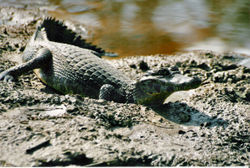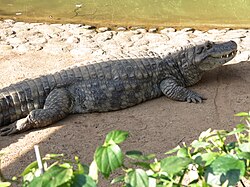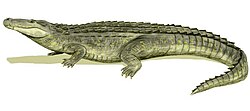Caiman
 From Wikipedia - Reading time: 11 min
From Wikipedia - Reading time: 11 min
| Caimans | |
|---|---|

| |
| Yacare caiman, Caiman yacare | |
| Scientific classification | |
| Domain: | Eukaryota |
| Kingdom: | Animalia |
| Phylum: | Chordata |
| Class: | Reptilia |
| Clade: | Archosauria |
| Order: | Crocodilia |
| Family: | Alligatoridae |
| Subfamily: | Caimaninae Brochu, 1999 |
| Type genus | |
| Caiman Spix, 1825
| |
| Subgroups | |
| |





A caiman (/ˈkeɪmən/ (also spelled cayman[3]) from Taíno kaiman[4][additional citation(s) needed]) is an alligatorid belonging to the subfamily Caimaninae, one of two primary lineages within the Alligatoridae family, the other being alligators. Caimans are native to Central and South America and inhabit marshes, swamps, lakes, and mangrove rivers. They have scaly skin and live a fairly nocturnal existence. They are relatively small-sized crocodilians with an average maximum weight of 6 to 40 kg (13 to 88 lb) depending on species, with the exception of the black caiman (Melanosuchus niger), which can grow more than 4 m (13 ft) long and weigh more than 450 kg (990 lb). The black caiman is the largest caiman species in the world and is found in the slow-moving rivers and lakes that surround the Amazon basin. The smallest species is the Cuvier's dwarf caiman (Paleosuchus palpebrosus), which grows to 1.2 to 1.5 m (3.9 to 4.9 ft) long. There are six different species of caiman found throughout the watery jungle habitats of Central and Southern America. The average length for most of the other caiman species is about 2 to 2.5 m (6.6 to 8.2 ft) long.
Caimans are distinguished from alligators, their closest relatives, by a few defining features: a lack of a bony septum between the nostrils, ventral armor composed of overlapping bony scutes formed from two parts united by a suture, and longer and sharper teeth than alligators. Caimans also tend to be more agile and crocodile-like in their movements.[5] The calcium rivets on caiman scales make their hides stiffer than those of alligators.
Several extinct forms are known, including Purussaurus, a giant Miocene genus that grew to 7.6–10 m (25–33 ft)[6] and the 5.89 m (19.3 ft) Mourasuchus, which had a wide duck-like snout.[6]
Behavior
[edit]Caimans are predators and, like alligators and crocodiles, their diet largely consists of fish. Caimans also hunt insects, birds, small mammals and reptiles.
Because of their large size and ferocious nature, caimans have few natural predators within their environments. Humans are their main predators, because the animals have been hunted for their meat and skin. Jaguars, anacondas and crocodiles are the only other predators of caimans, although they usually prey on the smaller specimens or specific species of caiman such as the Spectacled Caiman and Yacare caiman. During summer or droughts, caimans may dig a burrow and go into a form of summer hibernation called aestivation.
Female caimans build a large nest in which to lay their eggs. The nests can be more than 1.5 m (4.9 ft) wide. Female caimans lay between 10 and 50 eggs, which hatch within about six weeks. Once they have hatched, the mother caiman takes her young to a shallow pool of water, where they can learn how to hunt and swim. The juveniles of spectacled caiman have been shown to stay together in pods for up to 18 months.[7]

Phylogeny
[edit]Caimaninae is cladistically defined as Caiman crocodylus (the spectacled caiman) and all species closer to it than to Alligator mississippiensis (the American alligator).[8][9] This is a stem-based definition for caimaninae, and means that it includes more basal extinct caimanine ancestors that are more closely related to living caimans than to alligators. The clade Jacarea includes the most derived caimans, being defined as the last common ancestor of Caiman latirostris (Broad-snouted caiman), Caiman crocodilus (Spectacled caiman), Caiman yacare (Yacare caiman), Melanosuchus niger (Black caiman), and all its descendants.[1]
Below is a cladogram showing the phylogeny of Caimaninae, modified from Hastings et al. (2013).[10]
| |||||||||||||||||||||||||||||||||||||||||||||||||||||||||||||||||||||||||||||||
Here is an alternative cladogram from Bona et al. 2018.[11]
| Alligatoridae |
| |||||||||||||||||||||||||||||||||||||||||||||||||||||||||||||||||||||||||||||||||||||||||||||||||||||||||||||||
| (crown group) |
The Late Cretaceous taxa Stangerochampsa, Brachychampsa and Albertochampsa have been previously referred to as stem-group caimans,[11][1] but Walter et al. (2022) recovered them as the basalmost alligatorines based on phylogenetic analysis and claimed that the earliest definitive stem-group caimans are known from the earliest Paleocene.[12] A different study by Adam Cossette and David Tarailo in 2024 recovered Brachychampsa and relatives in a clade at the base of Caimaninae. They named this clade Brachychampsini, defining it as "the largest clade of alligatorids more closely related to Brachychampsa montana than to Caiman crocodilus or Alligator mississippiensis".[2]
See also
[edit]References
[edit]- ^ a b c Rio, Jonathan P.; Mannion, Philip D. (6 September 2021). "Phylogenetic analysis of a new morphological dataset elucidates the evolutionary history of Crocodylia and resolves the long-standing gharial problem". PeerJ. 9: e12094. doi:10.7717/peerj.12094. PMC 8428266. PMID 34567843.
- ^ a b Cossette, A. P.; Tarailo, D. A. (2024). "Crocodylian diversity during the early Eocene climatic optimum in the Golden Valley Formation of North Dakota, U.S.A." Journal of Vertebrate Paleontology. e2403579. doi:10.1080/02724634.2024.2403579.
- ^ Dictionary.com, retrieved February 16, 2021
- ^ Patte, Marie-France (2010). "Arawak vs. Lokono. What's in a name?". In Faraclas, Nicholas (ed.). In a Sea of Heteroglossia: Pluri-Lingualism, Pluri-Culturalism, and Pluri-Identification in the Caribbean. Curaçao: Fundashon pa Planifikashon di Idioma & Universiteit van de Nederlandse Antillen. p. 80. ISBN 978-99904-2-300-6.
- ^ Guggisberg, C.A.W. (1972). Crocodiles: Their Natural History, Folklore, and Conservation. David & Charles. p. 195. ISBN 978-0-7153-5272-4.
- ^ a b Paiva, Ana Laura S.; Godoy, Pedro L.; Souza, Ray B.B.; Klein, Wilfried; Hsiou, Annie S. (2022). "Body size estimation of Caimaninae specimens from the Miocene of South America". Journal of South American Earth Sciences. 118: 103970. doi:10.1016/j.jsames.2022.103970. ISSN 0895-9811.
- ^ Gorzula, S. J. (1978). "An Ecological Study of Caiman crocodilus crocodilus Inhabiting Savanna Lagoons in the Venezuelan Guayana". Oecologia. 35 (1): 21–34. ISSN 0029-8549. JSTOR 4215651.
- ^ Brochu, C. A. (2003). "Phylogenetic approaches toward crocodylian history" (PDF). Annual Review of Earth and Planetary Sciences. 31 (31): 357–97. Bibcode:2003AREPS..31..357B. doi:10.1146/annurev.earth.31.100901.141308. Archived from the original on 2015-04-02. Retrieved 2021-07-26.
- ^ Brochu, C. A. (2011). "Phylogenetic relationships of Necrosuchus ionensis Simpson, 1937 and the early history of caimanines". Zoological Journal of the Linnean Society. 163: S228 – S256. doi:10.1111/j.1096-3642.2011.00716.x.
- ^ Hastings, A. K.; Bloch, J. I.; Jaramillo, C. A.; Rincon, A. F.; MacFadden, B. J. (2013). "Systematics and biogeography of crocodylians from the Miocene of Panama". Journal of Vertebrate Paleontology. 33 (2): 239. Bibcode:2013JVPal..33..239H. doi:10.1080/02724634.2012.713814. S2CID 83972694.
- ^ a b Paula Bona; Martín D. Ezcurra; Francisco Barrios; María V. Fernandez Blanco (2018). "A new Palaeocene crocodylian from southern Argentina sheds light on the early history of caimanines". Proceedings of the Royal Society B: Biological Sciences. 285 (1885): 20180843. doi:10.1098/rspb.2018.0843. PMC 6125902. PMID 30135152.
- ^ Walter J, Darlim G, Massonne T, Aase A, Frey E, Rabi M (2022). "On the origin of Caimaninae: insights from new fossils of Tsoabichi greenriverensis and a review of the evidence". Historical Biology. 34 (4): 580–595. doi:10.1080/08912963.2021.1938563. S2CID 238723638.
 KSF
KSF

